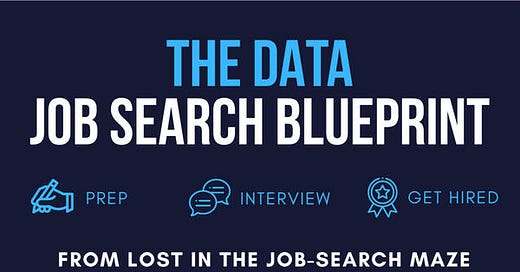Land Your First Data Job In 5 Actionable Steps: From Portfolio-Building To Crushing Your First Month
(Even if you’ve already applied to 150+ companies)
Hey there!
Struggling to get Data Science interviews? You're not alone.
Here’s a message we got recently:
and I have heard this story so many times—and we’ve lived it, too.
I remember sending out 50+ applications in two weeks and hearing nothing back.
No interviews.
No feedback.
Just... silence.
That’s why Sai and I created the Data Job Search Blueprint—a free 5-day email course to help early-career data scientists finally break through the wall and start getting interview calls.
This course walks you through:
✅ How to craft a standout portfolio
✅ How to message hiring managers without it feeling awkward
✅ How to apply with intention and see results
We’re launching July 17th—and it’ll only be available for 3 months. No archives. No replays.
Now, to give you a sneak peek, here are 5 tactical shifts you’ll learn inside the Blueprint.
Let’s dive in 👇
1. Build a portfolio that gets interviews, not compliments.
Most portfolios don’t fail because the projects are bad—they fail because the storytelling is missing.
Here’s how to fix that:
Showcase 2–3 real-world projects that solve specific problems
Write short, clear project summaries (what problem, what data, what impact)
Host your work on GitHub, Notion, or a simple site that doesn’t crash
Tailor one project to the kind of role you’re applying for (analytics ≠ ML ≠ product)
If your portfolio doesn’t make a hiring manager say “this person gets it”—you’re leaving interviews on the table.
2. Network like a human, not a hustler.
You don’t need to spam 100 people on LinkedIn.
Instead, do this:
Start by messaging alumni from your school or bootcamp
Use a 3-line message: who you are, why you're reaching out, what you’d like
Join active LinkedIn comment sections where hiring managers hang out
Stay top of mind by occasionally sharing useful content or a progress update
Pro tip: People hire people they know. Don’t wait for job posts—start building relationships early.
3. Apply smart—1 focused action per day beats 100 random ones.
More applications ≠ better results.
Here’s a smarter system:
Limit yourself to 1 meaningful action per day (apply, connect, or follow up)
Keep a simple tracker to avoid applying to the same job twice
Customize your resume for each role based on the posting
Hiring managers can spot mass applications a mile away.
Give them a reason to pause—and read.
4. Interview like a teammate, not a test-taker.
Want to stand out in interviews? Act like someone they’d want on their team.
Here’s how:
Practice solving problems out loud (your thought process is the product)
Use STAR format to prep for behavioral questions
Learn how to guide a technical walkthrough with business context
Ask good questions about the team, tools, and challenges—not just “what’s next?”
Confidence isn’t about having all the answers.
It’s about showing you know how to figure them out.
5. Rejections aren’t the end—they’re your R&D.
Here’s what most people do after a rejection: nothing.
Here’s what you should do:
Follow up and ask for specific feedback (even if you don’t get it, you signal maturity)
Review the job post and reflect: did your materials match the role?
Use this line: “If you know anyone hiring for roles like X, I’d be grateful for a warm intro.”
One “no” can become your next “yes”—if you know how to use it.
🎁 Want early access + exclusive bonuses?
If this breakdown helped, you’ll love the Data Job Search Blueprint.
Inside the full course, you’ll get:
✅ Templates for cold outreach and resume writing
✅ Tactical guidance for interviews and follow-ups
✅ Notion templates, mini-challenges, and bonus tools
✅ All in a daily email that takes 15 minutes or less to action
We start July 17th. It’s free. And there are no replays.
Only action-takers will get in.
Let’s get you out of the application void—and into real conversations with real teams.
We’ve got you.






Thanks
Very excited for this!!